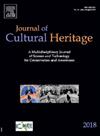意大利都灵东方艺术博物馆收藏的辽代稀有银质圣物匣无损表征
IF 3.3
2区 综合性期刊
0 ARCHAEOLOGY
引用次数: 0
摘要
本研究的重点是对一件精美银器的考古调查。从风格上看,这件文物可能属于中国辽朝(公元907-1125年),并展示了一些特殊的方面。它是由五个重叠和松散的银箔组成的,这些银箔可能是从不相关的人工制品中取出的,并在古代重新组装而成。然而,来源信息非常少,其制造过程是未知的。此外,发现的圣物盒处于高度破碎的状态,腐蚀严重,银箔大面积泛黄,严重脆化,严重损害了其结构完整性和装饰特征的易读性。因此,基于表面光谱技术和结构表征的非破坏性和多分析方法,对从圣物箱中自发分离的微碎片进行了研究。本研究考察了这一独特圣物箱的材料和制造工艺、保存历史以及五个组成部分的一致性。研究结果为研究辽代的金属加工实践提供了新的认识,并对制定和优化恢复脆性古代银器结构完整性的策略具有重要价值。本文章由计算机程序翻译,如有差异,请以英文原文为准。
The non-destructive characterization of a rare Liao silver reliquary from the Museum of oriental art in Turin (Italy)
The present research study focuses on the archaeometric investigation of a delicate silver object. The artefact may be stylistically attributed to the Chinese Liao dynasty (907–1125 AD) and exhibits some peculiar aspects. It is made up of five overlapping and untied silver foil components, which may have been taken from unrelated artefacts and reassembled in ancient times. However, very little provenance information is available, and its manufacturing process is unknown. In addition, the reliquary was found in a highly fragmentary state, with advanced corrosion, extensive yellowing of the silver foils and severe embrittlement, which highly compromised its structural integrity and the legibility of its decorative features. Thus, a non-destructive and multi-analytical approach, based on surface spectroscopic techniques and structural characterization, was carried out on micro-fragments detached spontaneously from the reliquary. This study investigates the materials and manufacturing techniques, the conservation history, and the coherence of the five assembled components of this unique reliquary. Moreover, the investigation allowed us to gain insight into the silver microstructure and the possible causes of the observed alteration phenomena The results provide new knowledge on the metalworking practices of the Liao dynasty and might be valuable for developing and optimising strategies to restore the structural integrity of brittle ancient silver artefacts.
求助全文
通过发布文献求助,成功后即可免费获取论文全文。
去求助
来源期刊

Journal of Cultural Heritage
综合性期刊-材料科学:综合
CiteScore
6.80
自引率
9.70%
发文量
166
审稿时长
52 days
期刊介绍:
The Journal of Cultural Heritage publishes original papers which comprise previously unpublished data and present innovative methods concerning all aspects of science and technology of cultural heritage as well as interpretation and theoretical issues related to preservation.
 求助内容:
求助内容: 应助结果提醒方式:
应助结果提醒方式:


